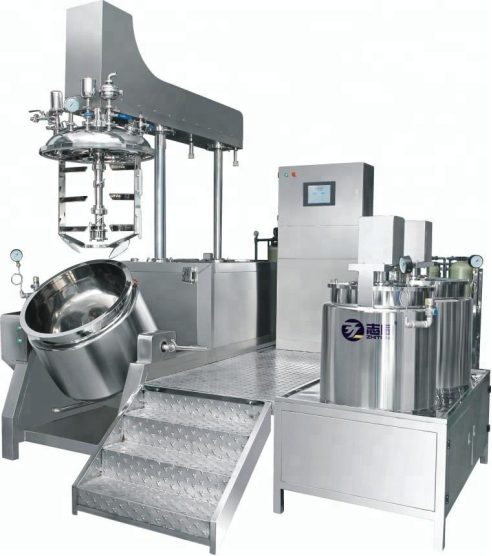Vacuum emulsifier is vacuum emulsification. It refers to the use of high shear emulsifier to quickly and uniformly distribute one phase or multiple phases into another continuous phase under the state of vacuum, and then use the strong kinetic energy brought by the machine. , so that the material can withstand hundreds of thousands of hydraulic shears per minute in the narrow gap between the stator and the rotor. The comprehensive action of centrifugal extrusion, impact, tearing, etc., instantly and evenly disperses and emulsifies, and after high-frequency reciprocation, finally obtains high-quality products with no bubbles, delicate and stable.
Vacuum emulsifier The vacuum emulsifier is mainly composed of a pretreatment pot, a main pot, a vacuum pump, a hydraulic pressure, and an electrical control system. After the materials in the water pot and oil pot are fully dissolved, they are mixed and homogeneously emulsified by the vacuum main pot. Emulsifiers are also widely used in the pharmaceutical industry, daily chemicals and other industries.
Here are some introductions for you: heating can be used to heat materials, and the heating temperature can be set arbitrarily and automatically controlled. The material can be cooled by connecting the cooling liquid in the interlayer, the operation is simple and convenient, and there is a thermal insulation layer outside the interlayer. The homogenizing system and stirring system can be used separately or simultaneously. The micronization, emulsification, mixing, homogenization and dispersion of materials can be completed in a short time.
We all know that most of them are mainly composed of water, and most of them are things with added oils and fats. If oil and water are put together, the oil will usually float to the surface, that is, the oil and water will separate. Why are oil and water not separated? Most of the equipment used for non-separation of oil and water is the emulsifier. In the production process, the oil and water are used to form the emulsification effect through the functions of stirring, heating, vacuum, and homogenization in the production process. The blending of water and oil is mainly by means of surfactants, also known as emulsifiers. They can change the surface energy at the junction of oil and water, and it is also a process of solubilization: surfactants form micelles in aqueous solutions, which significantly increases the solubility of insoluble or slightly water-soluble organics, so that oil droplets are evenly dispersed in Water, or letting water distribute in oil, is often referred to as emulsification. The first (A): Solubilizes the solubilized material in the hydrophobic-based core of the surfactant. The second (B): the solubilized substance and the surfactant form a fence structure similar to the mixed micelle solubilization of the surfactant.
Post time: Apr-14-2022





